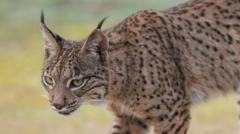The Iberian lynx, distinguished by its striking leopard-like spots, has made a remarkable comeback in recent years. Once on the brink of extinction, their population has now surged to over 2,000 in the wild across Spain and Portugal. This increase indicates a significant improvement from merely two decades ago, when fewer than 100 lynxes remained, with only 25 of those being females capable of reproduction. Rodrigo Serra, who oversees the lynx reproduction programs in these countries, notes, "The Iberian lynx was very, very close to extinction."
The decline in the lynx population was fueled by several factors, including habitat loss due to agriculture, rising road fatalities, and a sharp decrease in their primary prey, wild rabbits, which suffered a catastrophic decline due to pandemics. By 2005, Portugal had lost its last lynxes. However, that year marked the beginning of a dedicated breeding effort in Spain, leading to the opening of a National Breeding Centre for Iberian lynxes in Silves, Algarve, aimed at reintegrating them into the wild.
At the breeding center, lynxes are closely monitored to ensure their readiness for life outside captivity. Strategies are employed to prevent the animals from associating humans with food. They are fed through a tunnel system, with efforts made to instill natural wariness of humans. Serra explains, "When we notice a litter is becoming a bit more confident, we go in and chase them... We're training them not to get close to people."
Genetics play a vital role in the reintroduction process, allowing for the careful distribution of lynxes to reduce inbreeding and disease risk. Pedro Sarmento, who has studied the Iberian lynx for three decades, leads the efforts in Portugal, noting some challenges that arise as their numbers grow. Though there have been isolated incidents of lynxes preying on chickens, strategies like reinforcing coops and monitoring lynx movements are helping to mitigate any potential tensions with local farmers.
The story of Lítio, a lynx initially released in Portugal, illustrates the challenges faced. After losing track of him for a period, he made a treacherous trek back to Spain but was later re-captured and released again. This time, he successfully settled down and has since become a contributing member of the local lynx population.
With over 30 years of conservation efforts, the lynx species has been effectively saved from the brink of extinction. Sarmento hopes their numbers can reach a sustainable level of 5,000-6,000 in the wild by 2035, ultimately achieving a favorable conservation status. As their presence re-establishes in nature, Sarmento expresses his long-held hope: "It's surreal that we're in a place where we can see lynxes in nature or through camera trapping almost daily." Despite successes, the team remains vigilant, noting that road accidents accounted for 80% of lynx deaths in the past year, highlighting the ongoing challenges that accompany conservation efforts.
The decline in the lynx population was fueled by several factors, including habitat loss due to agriculture, rising road fatalities, and a sharp decrease in their primary prey, wild rabbits, which suffered a catastrophic decline due to pandemics. By 2005, Portugal had lost its last lynxes. However, that year marked the beginning of a dedicated breeding effort in Spain, leading to the opening of a National Breeding Centre for Iberian lynxes in Silves, Algarve, aimed at reintegrating them into the wild.
At the breeding center, lynxes are closely monitored to ensure their readiness for life outside captivity. Strategies are employed to prevent the animals from associating humans with food. They are fed through a tunnel system, with efforts made to instill natural wariness of humans. Serra explains, "When we notice a litter is becoming a bit more confident, we go in and chase them... We're training them not to get close to people."
Genetics play a vital role in the reintroduction process, allowing for the careful distribution of lynxes to reduce inbreeding and disease risk. Pedro Sarmento, who has studied the Iberian lynx for three decades, leads the efforts in Portugal, noting some challenges that arise as their numbers grow. Though there have been isolated incidents of lynxes preying on chickens, strategies like reinforcing coops and monitoring lynx movements are helping to mitigate any potential tensions with local farmers.
The story of Lítio, a lynx initially released in Portugal, illustrates the challenges faced. After losing track of him for a period, he made a treacherous trek back to Spain but was later re-captured and released again. This time, he successfully settled down and has since become a contributing member of the local lynx population.
With over 30 years of conservation efforts, the lynx species has been effectively saved from the brink of extinction. Sarmento hopes their numbers can reach a sustainable level of 5,000-6,000 in the wild by 2035, ultimately achieving a favorable conservation status. As their presence re-establishes in nature, Sarmento expresses his long-held hope: "It's surreal that we're in a place where we can see lynxes in nature or through camera trapping almost daily." Despite successes, the team remains vigilant, noting that road accidents accounted for 80% of lynx deaths in the past year, highlighting the ongoing challenges that accompany conservation efforts.






















